Physical, Mechanical, and Durability Properties of Concrete Containing Wood Chips and Sawdust: An Experimental Approach
Abstract
:1. Introduction
2. Materials and Methods
2.1. Characterization of Materials
2.2. Mix Design
2.3. Mechanical, Durability, and Hygrothermal Tests
2.3.1. Physical and Mechanical Characterization
Compressive Strength
Poisson’s Ratio and Modulus of Elasticity
Flexural Strength
2.3.2. Durability
Compressive Strength Development
Wet–Dry Cycles
Freeze–Thaw Cycles
Thermal Shock Cycles
2.3.3. Hygrothermal Characterization
Thermal Conductivity
Water Absorption
Shrinkage and Expansion
3. Results
3.1. Mechanical Performance
3.1.1. Compressive Strength
3.1.2. Dynamic Elastic Properties
3.1.3. Flexural Strength
3.2. Durability
3.2.1. Compressive Strength Development
3.2.2. Wetting–Drying, Freeze–Thaw, and Thermal Shock Cycles
3.3. Hygrothermal Behavior
3.3.1. Thermal Conductivity
3.3.2. Water Absorption
3.3.3. Shrinkage and Expansion
4. Discussion
4.1. Mechanical Characterization
4.2. Durability
4.3. Hygrothermal Characterization
5. Conclusions
Author Contributions
Funding
Institutional Review Board Statement
Informed Consent Statement
Data Availability Statement
Acknowledgments
Conflicts of Interest
References
- Mantau, U.; Saal, U.; Prins, K.; Steierer, F.; Lindner, M.; Verkerk, H.; Eggers, J.; Leek, N.; Oldenburger, J.; Asikainen, A.; et al. Real Potential for Changes in Growth and Use of EU Forests; Final Report; EuWood: Hamburg, Germany, June 2010; Available online: https://franzjosefadrian.com/wp-content/uploads/2013/06/euwood_final_report.pdf (accessed on 29 November 2021).
- Bourguignon, D. Understanding Waste Streams Treatment of Specific Waste. 2015. Available online: https://www.europarl.europa.eu/EPRS/EPRS-Briefing-564398-Understanding-waste-streams-FINAL.pdf (accessed on 29 November 2021).
- Mayer, A.; Haas, W.; Wiedenhofer, D.; Krausmann, F.; Nuss, P.; Blengini, G. Measuring progress towards a Circular Economy—A monitoring framework for economy-wide material loop closing in the EU28. J. Ind. Ecol. 2019, 1, 62–76. [Google Scholar] [CrossRef] [Green Version]
- Bergeron, F.C. Assessment of the coherence of the Swiss waste wood management. Resour. Conserv. Recycl. 2014, 91, 62–70. [Google Scholar] [CrossRef]
- Ashori, A.; Tabarsa, T.; Amosi, F. Evaluation of using waste timber railway sleepers in wood-cement composite materials. Constr. Build. Mater. 2012, 27, 126–129. [Google Scholar] [CrossRef]
- Cheah, C.B.; Ramli, M. The implementation of wood waste ash as a partial cement replacement material in the production of structural grade concrete and mortar: An overview. Resour. Conserv. Recycl. 2011, 55, 669–685. [Google Scholar] [CrossRef]
- Li, M.; Khelifa, M.; El Ganaoui, M. Mechanical characterization of concrete containing wood shavings as aggregates. Int. J. Sustain. Built Environ. 2017, 6, 587–596. [Google Scholar] [CrossRef]
- Siddique, R.; Singh, M.; Mehta, S.; Belarbi, R. Utilization of treated saw dust in concrete as partial replacement of natural sand. J. Clean. Prod. 2020, 261, 121226. [Google Scholar] [CrossRef]
- Blankenhorn, P.R.; Blankenhorn, B.D.; Silsbee, M.R.; DiCola, M. Effects of fiber surface treatments on mechanical properties of wood fiber–cement composites. Cem. Concr. Res. 2001, 31, 1049–1055. [Google Scholar] [CrossRef]
- Prachasaree, W.; Limkatanyu, S.; Hawa, A. Parawood particle cement composite boards under accelerated wet/dry cycling and natural aging. J. Sustain. Cem. Mater. 2013, 2, 227–237. [Google Scholar] [CrossRef]
- Dias, S.; Almeida, J.; Santos, B.; Humbert, P.; Tadeu, A.; António, J.; de Brito, J.; Pinhão, P. Lightweight cement composites containing end-of-life treated wood—Leaching, hydration and mechanical tests. Constr. Build. Mater. 2021, 317, 125931. [Google Scholar] [CrossRef]
- Schmidt, W.; Alexander, M.; John, V.M. Education for sustainable use of cement based materials. Cem. Concr. Res. 2018, 114, 103–114. [Google Scholar] [CrossRef]
- Chen, Y.; Wu, F.; Yu, Q.; Brouwers, H.J.H. Bio-based ultra-lightweight concrete applying miscanthus fibers: Acoustic absorption and thermal insulation. Cem. Concr. Compos. 2020, 114, 103829. [Google Scholar] [CrossRef]
- Zwicky, D. Mechanical properties of organic-based lightweight concretes and their impact on economic and ecological performances. Constr. Build. Mater. 2020, 245, 118413. [Google Scholar] [CrossRef]
- Caldas, L.R.; Saraiva, A.B.; Lucena, A.F.; Da Gloria, M.Y.; Santos, A.S.; Filho, R.D.T. Building materials in a circular economy: The case of wood waste as CO2-sink in bio concrete. Resour. Conserv. Recycl. 2020, 166, 105346. [Google Scholar] [CrossRef]
- Bederina, M.; Marmoret, L.; Mezreb, K.; Khenfer, M.; Bali, A.; Quéneudec, M. Effect of the addition of wood shavings on thermal conductivity of sand concretes: Experimental study and modelling. Constr. Build. Mater. 2007, 21, 662–668. [Google Scholar] [CrossRef]
- Zwicky, D. Mechanical properties of wood-cement compounds. In Proceedings of the 10th Conference on Advanced Building Skins, Berne, Switzerland, November 2015; Available online: https://www.researchgate.net/publication/283730309 (accessed on 1 March 2022).
- Fu, Q.; Yan, L.; Ning, T.; Wang, B.; Kasal, B. Interfacial bond behavior between wood chip concrete and engineered timber glued by various adhesives. Constr. Build. Mater. 2019, 238, 117743. [Google Scholar] [CrossRef]
- Fadiel, A.A.; Abu-Lebdeh, T.; Petrescu, F.I.T. Assessment of Woodcrete Using Destructive and Non-Destructive Test Methods. Materials 2022, 15, 3066. [Google Scholar] [CrossRef]
- Fadiel, A.A.M.; Abu-Lebdeh, T. Mechanical Properties of Concrete Including Wood Shavings as Fine Aggregates. Am. J. Eng. Appl. Sci. 2021, 14, 478–487. [Google Scholar] [CrossRef]
- Dominguez-Santos, D.; Mora-Melia, D.; Pincheira-Orellana, G.; Ballesteros-Pérez, P.; Retamal-Bravo, C. Mechanical Properties and Seismic Performance of Wood-Concrete Composite Blocks for Building Construction. Materials 2019, 12, 1500. [Google Scholar] [CrossRef] [Green Version]
- Batool, F.; Islam, K.; Cakiroglu, C.; Shahriar, A. Effectiveness of wood waste sawdust to produce medium- to low-strength concrete materials. J. Build. Eng. 2021, 44, 103237. [Google Scholar] [CrossRef]
- Fu, Q.; Yan, L.; Ning, T.; Wang, B.; Kasal, B. Behavior of adhesively bonded engineered wood—Wood chip concrete composite decks: Experimental and analytical studies. Constr. Build. Mater. 2020, 247, 118578. [Google Scholar] [CrossRef]
- Ahmed, W.; Khushnood, R.A.; Memon, S.A.; Ahmad, S.; Baloch, W.L.; Usman, M. Effective use of sawdust for the production of eco-friendly and thermal-energy efficient normal weight and lightweight concretes with tailored fracture properties. J. Clean. Prod. 2018, 184, 1016–1027. [Google Scholar] [CrossRef]
- Hafidh, S.A.; Abdullah, T.A.; Hashim, F.G.; Mohmoud, B.K. Effect of Adding Sawdust to Cement on its Thermal Conductivity and Compressive Strength. IOP Conf. Ser. Mater. Sci. Eng. 2021, 1094, 012047. [Google Scholar] [CrossRef]
- Sosoi, G.; Abid, C.; Barbuta, M.; Burlacu, A.; Balan, M.C.; Branoaea, M.; Vizitiu, R.S.; Rigollet, F. Experimental Investigation on Mechanical and Thermal Properties of Concrete Using Waste Materials as an Aggregate Substitution. Materials 2022, 15, 1728. [Google Scholar] [CrossRef] [PubMed]
- EN 933-1; Tests for Geometrical Properties of Aggregates. Determination of Particle Size Distribution. Sieving Method. European Committee for Standardization: Brussels, Belgium, 2012.
- EN 1097-6; Tests for Mechanical and Physical Properties of Aggregates. Determination of Particle Density and Water Absorption. European Committee for Standardization: Brussels, Belgium, 2013.
- EN 1097-5; Tests for Mechanical and Physical Properties of Aggregates-Determination of the Water Content by Drying in a Ventilated Oven. European Committee for Standardization: Brussels, Belgium, 2008.
- ACI Committee 318; ACI CODE 318-08: Building Code Requirements for Structural Concrete and Commentary. American Concrete Institute: Farmington Hills, MI, USA, 2007; ISBN 9780870312649.
- EN 12390-3; Testing Hardened Concrete—Part 3: Compressive Strength of Test Specimens. European Committee for Standardization: Brussels, Belgium, 2019.
- EN 12371; Natural Stone Test Methods. Determination of Frost Resistance. European Committee for Standardization: Brussels, Belgium, 2010.
- EN 1602; Thermal Insulating Products for Building Applications-Determination of the Apparent Density. European Committee for Standardization: Brussels, Belgium, 2013.
- Nogueira, C.L.; Rens, K.L. Ultrasonic wave propagation in EPS lightweight concrete and effective elastic properties. Constr. Build. Mater. 2018, 184, 634–642. [Google Scholar] [CrossRef]
- Jalal, M.; Grasley, Z.; Nassir, N.; Jalal, H. Strength and dynamic elasticity modulus of rubberized concrete designed with ANFIS modeling and ultrasonic technique. Constr. Build. Mater. 2020, 240, 117920. [Google Scholar] [CrossRef]
- EN ISO 10545–9; Ceramic Tiles—Part 9: Determination of Resistance to Thermal Shock. European Committee for Standardization: Brussels, Belgium, 2013.
- ISO 8302; Thermal Insulation—Determination of Steady-State Thermal Resistance and Related Properties—Guarded Hot Plate Apparatus. International Organization for Standardization: Geneva, Switzerland, 1991.
- EN 12664; Thermal Performance of Building Materials and Products—Determination of Thermal Resistance by Means of Guarded Hot Plate and Heat Flow Meter Methods—Dry and Moist Products of Medium and Low Thermal Resistance. European Committee for Standardization: Brussels, Belgium, 2001.
- EN ISO 15148; Hygrothermal performance of building materials and products—Determination of water absorption coefficient by partial immersion. European Committee for Standardization: Brussels, Belgium, 2002.
- E 398-1993; Betões—Determinação da Retracção e da Expansão. Laboratório Nacional de Engenharia Civil: Lisbon, Portugal, 1993; ISSN 0870-8592.
- Morales-Conde, M.; Rodríguez-Liñán, C.; Rojas, M.A.P. Physical and mechanical properties of wood-gypsum composites from demolition material in rehabilitation works. Constr. Build. Mater. 2016, 114, 6–14. [Google Scholar] [CrossRef]
- Beltran, M.G.S.; Schlangen, E. Interface bond characteristics between wood fibres and a cement matrix. In Brittle Matrix Composites 9, BMC 2009; Brandt, A.M., Olek, J., Marshall, I.H., Eds.; Warsaw, IFTR and Woodhead Publish: Warsaw, Poland, 2009; pp. 43–51. [Google Scholar] [CrossRef]
- EN 1992-1-1:2004 + AC:2008 Pt; Eurocode 2—Design of Concrete Structures—Part 1-1: General Rules and Rules for Buildings. European Committee for Standardization: Brussels, Belgium, 2004.
- Pal, P. Dynamic Poisson’s Ratio and Modulus of Elasticity of Pozzolana Portland Cement Concrete. Int. J. Eng. Technol. Innov. 2019, 9, 13–14. Available online: https://www.researchgate.net/publication/331868482 (accessed on 5 August 2022).
- Chen, B.T.; Chang, T.-P. Determining Dynamic Poisson’s Ratio in Concrete Based on Lateral Impact Echo Information. 2010. Available online: https://www.researchgate.net/publication/280239680 (accessed on 5 August 2022).
- Zhang, J.J.; Bentley, L.; Bentley, L.R. Factors Determining Poisson’s Ratio. 2005. Available online: https://www.researchgate.net/publication/265451756 (accessed on 5 August 2022).
- Zhang, S.P.; Zong, L. Evaluation of Relationship between Water Absorption and Durability of Concrete Materials. Adv. Mater. Sci. Eng. 2014, 2014, 650373. [Google Scholar] [CrossRef] [Green Version]
- Mehta, P.K.; Monteiro, P.J.M. Concrete, Microstructure, Properties and Materials, 3rd ed.; McGraw-Hill Education: New York, NY, USA, 2006. [Google Scholar]
- Carrillo, J.; Ramirez, J.; Lizarazo-Marriaga, J. Modulus of elasticity and Poisson’s ratio of fiber-reinforced concrete in Colombia from ultrasonic pulse velocities. J. Build. Eng. 2019, 23, 18–26. [Google Scholar] [CrossRef]
- Hassan, A.M.T.; Jones, S.W. Non-destructive testing of ultra high performance fibre reinforced concrete (UHPFRC): A feasibility study for using ultrasonic and resonant frequency testing techniques. Constr. Build. Mater. 2012, 35, 361–367. [Google Scholar] [CrossRef]
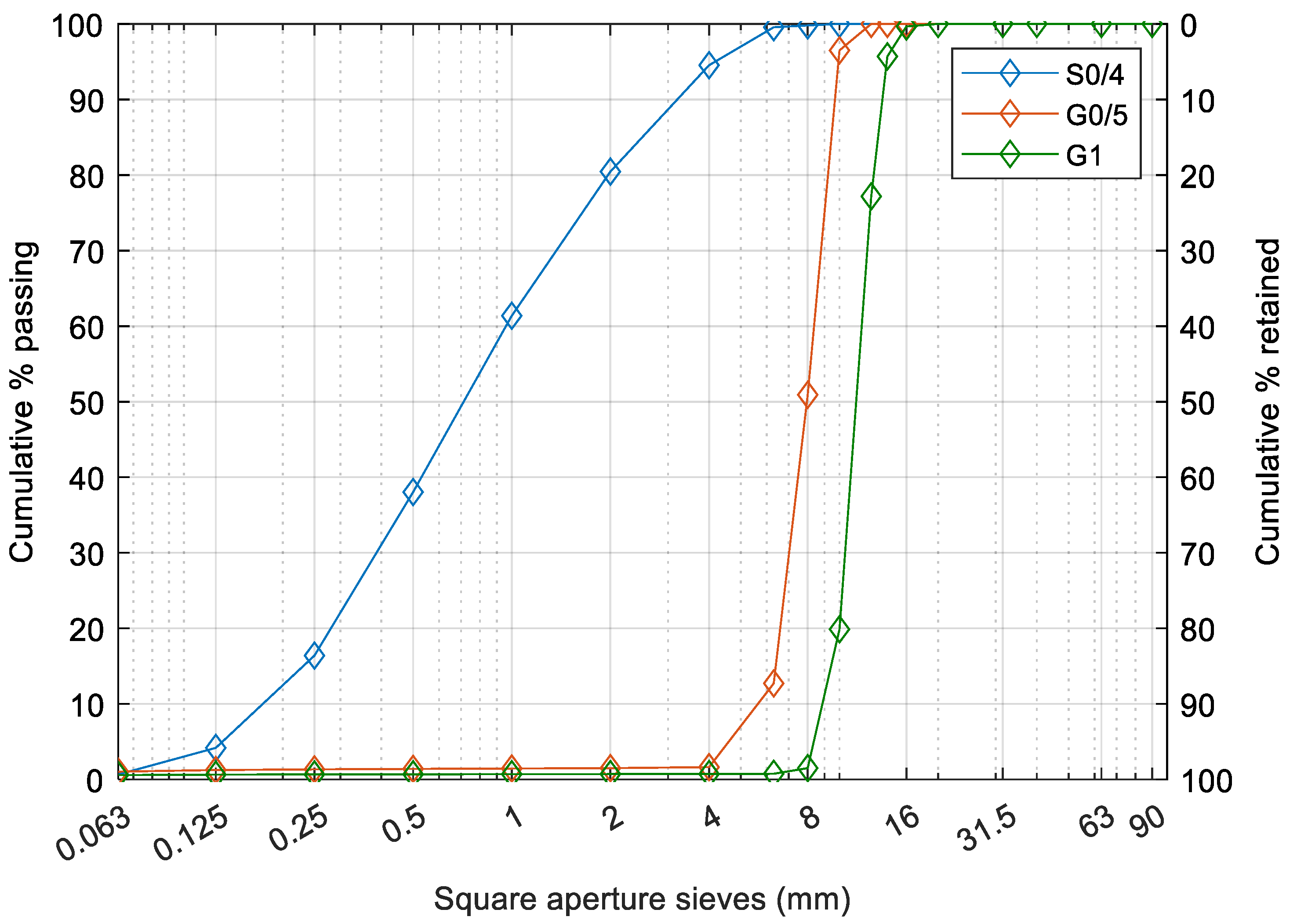

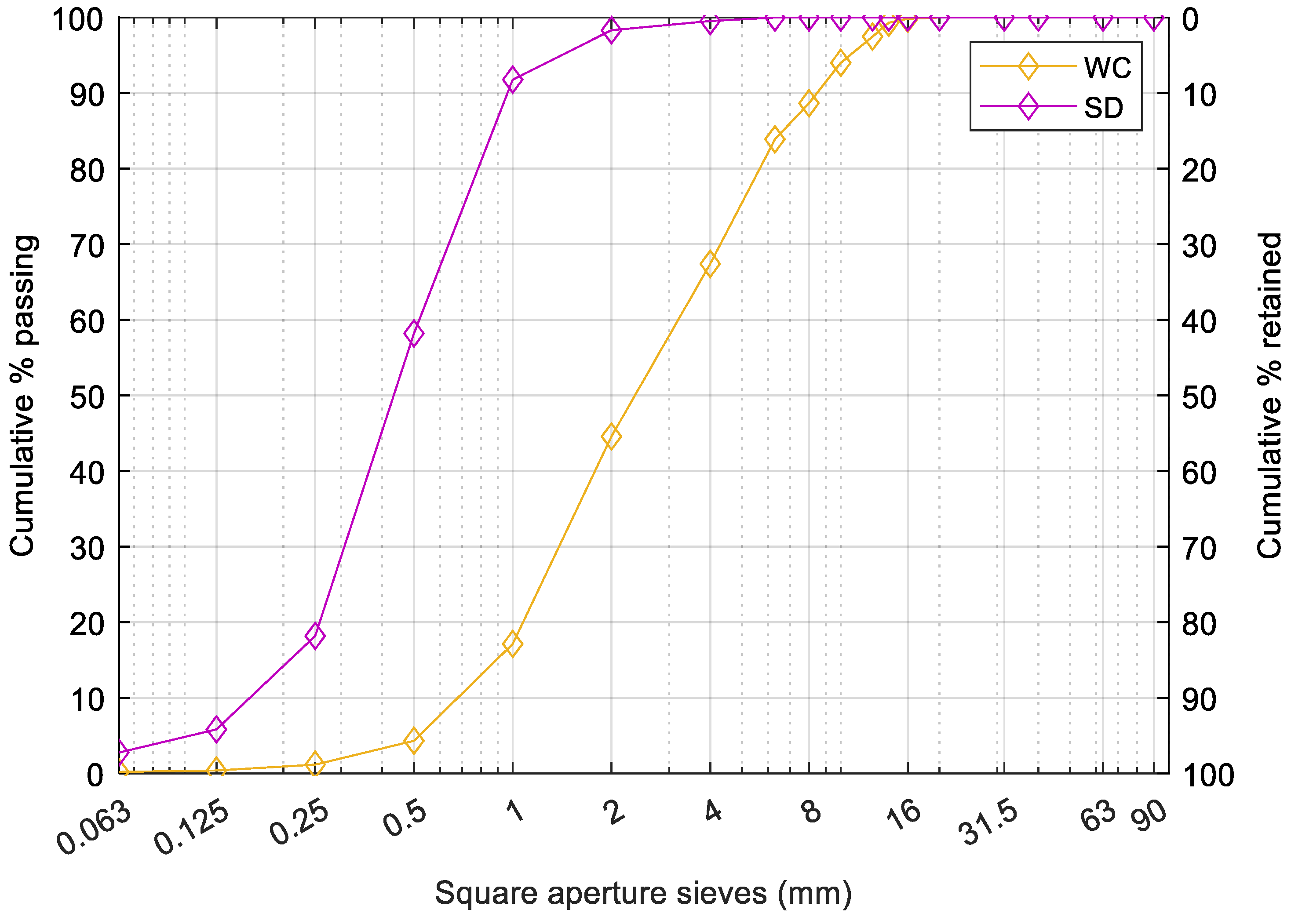


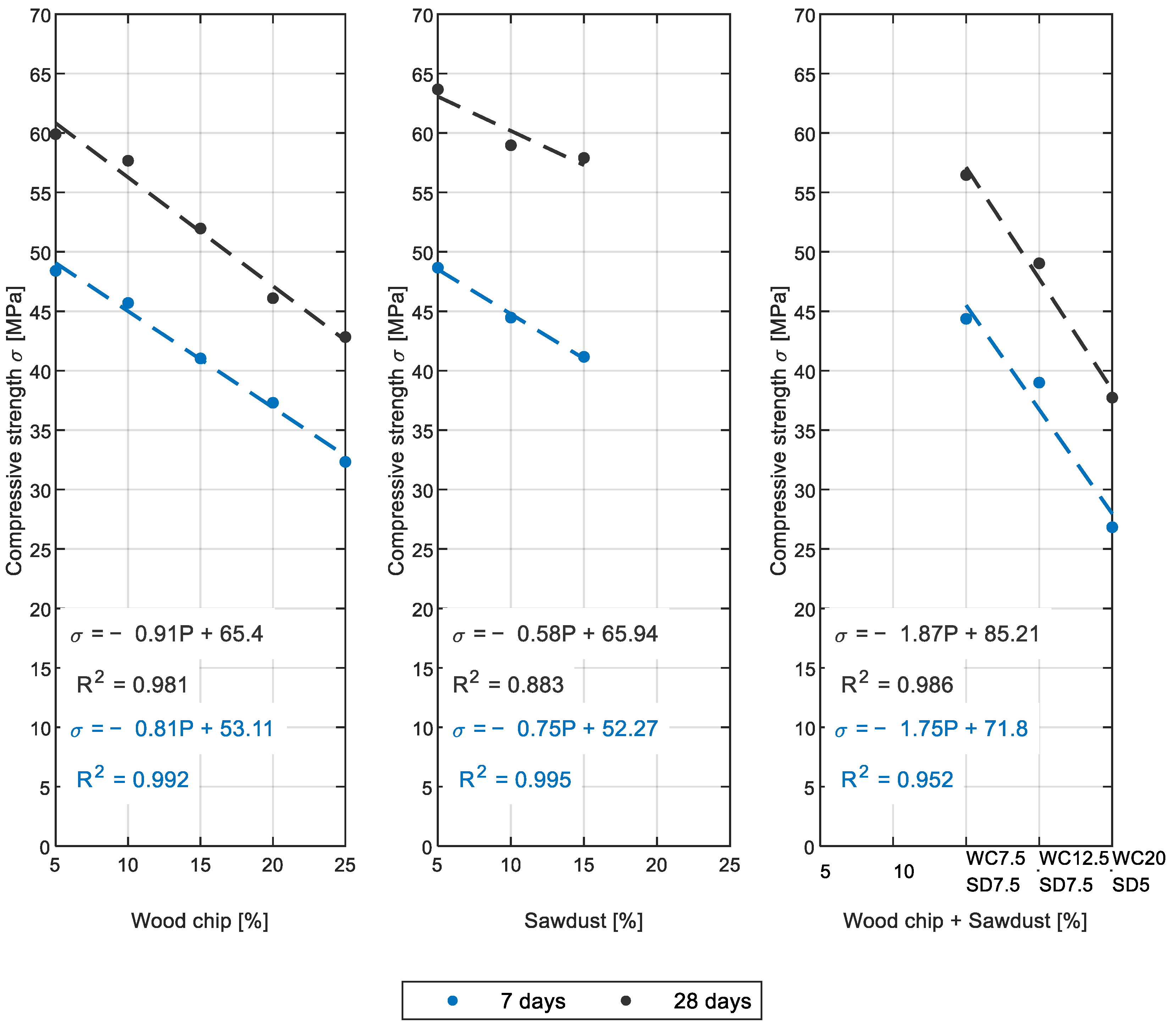

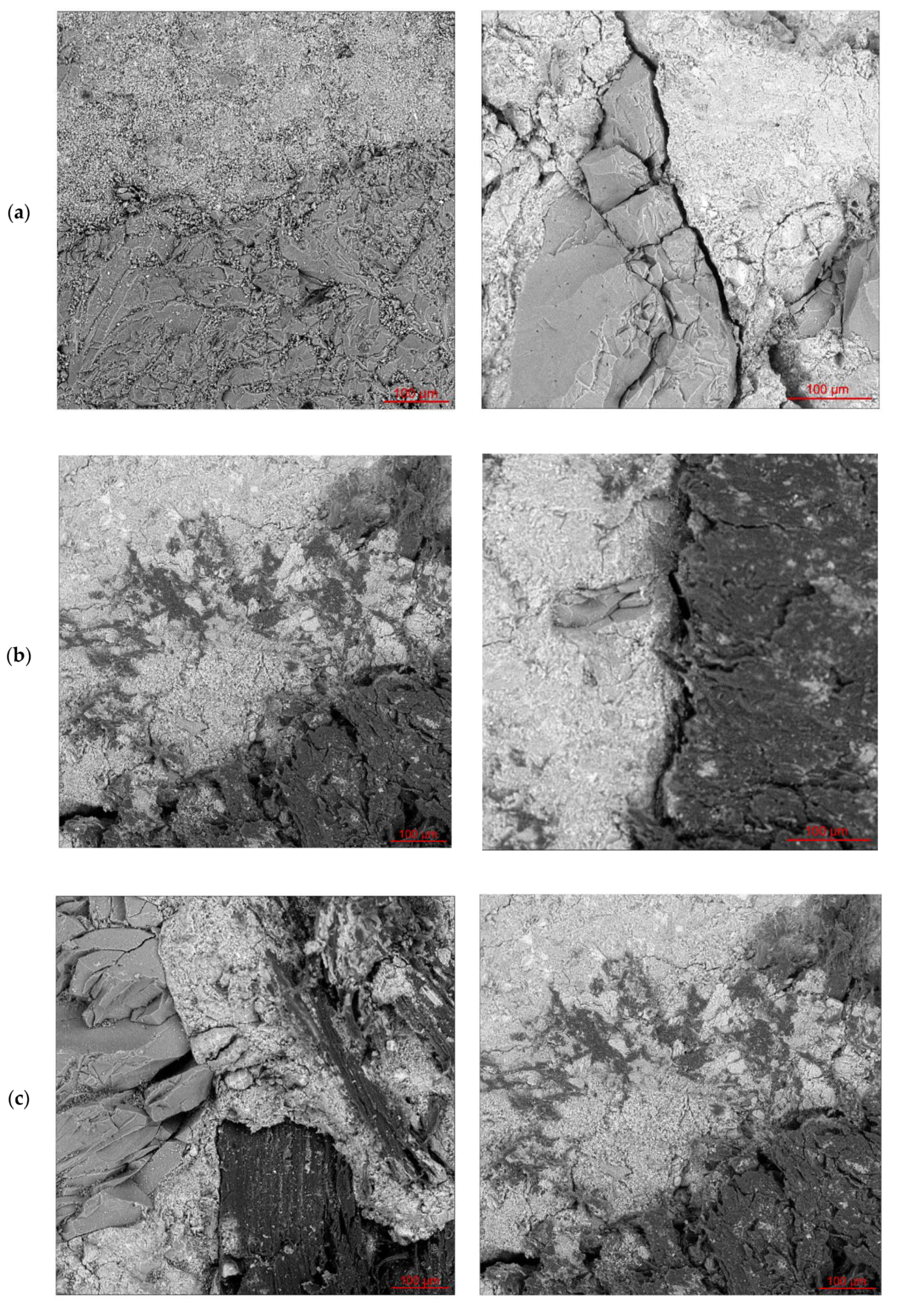
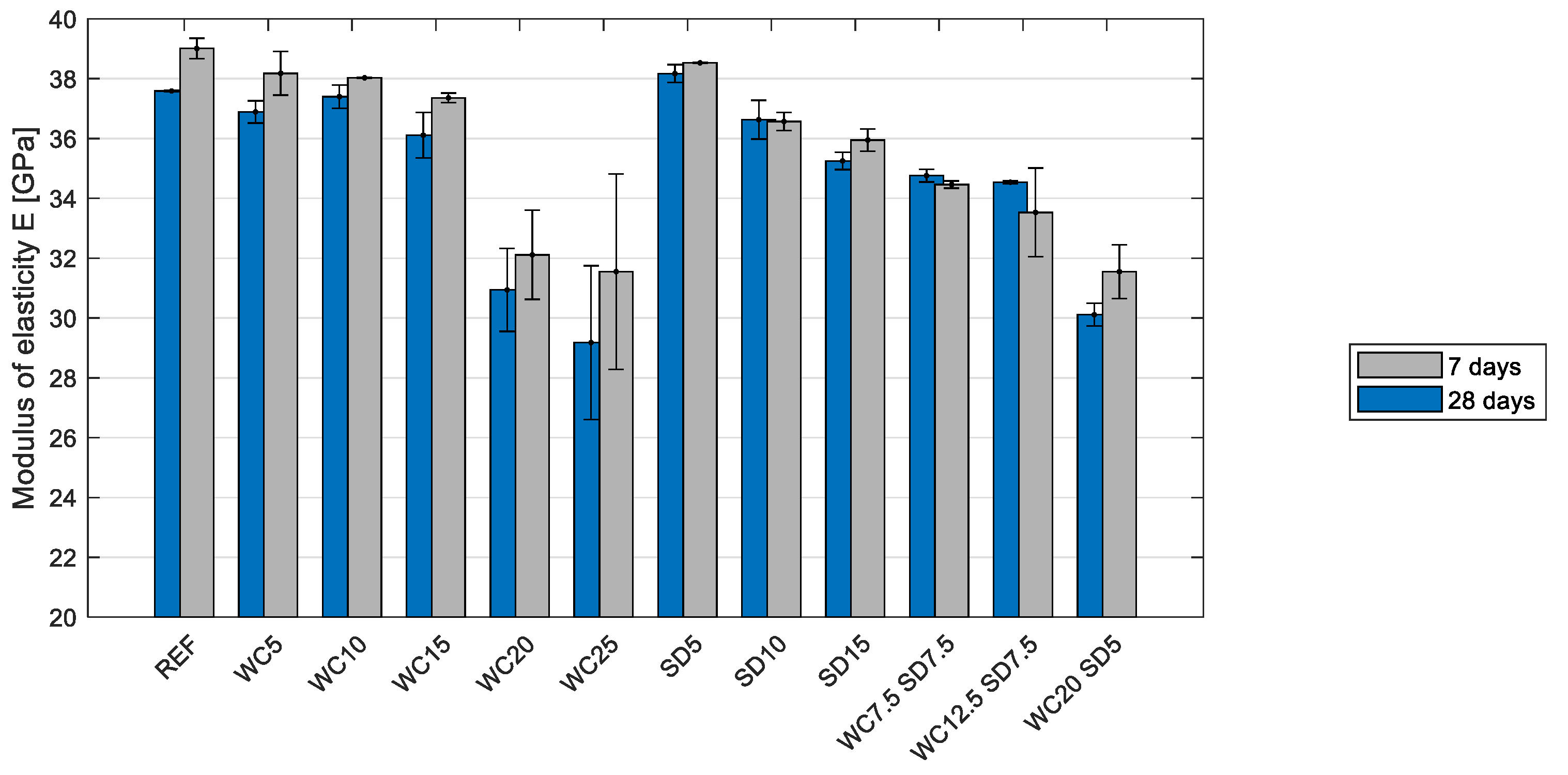
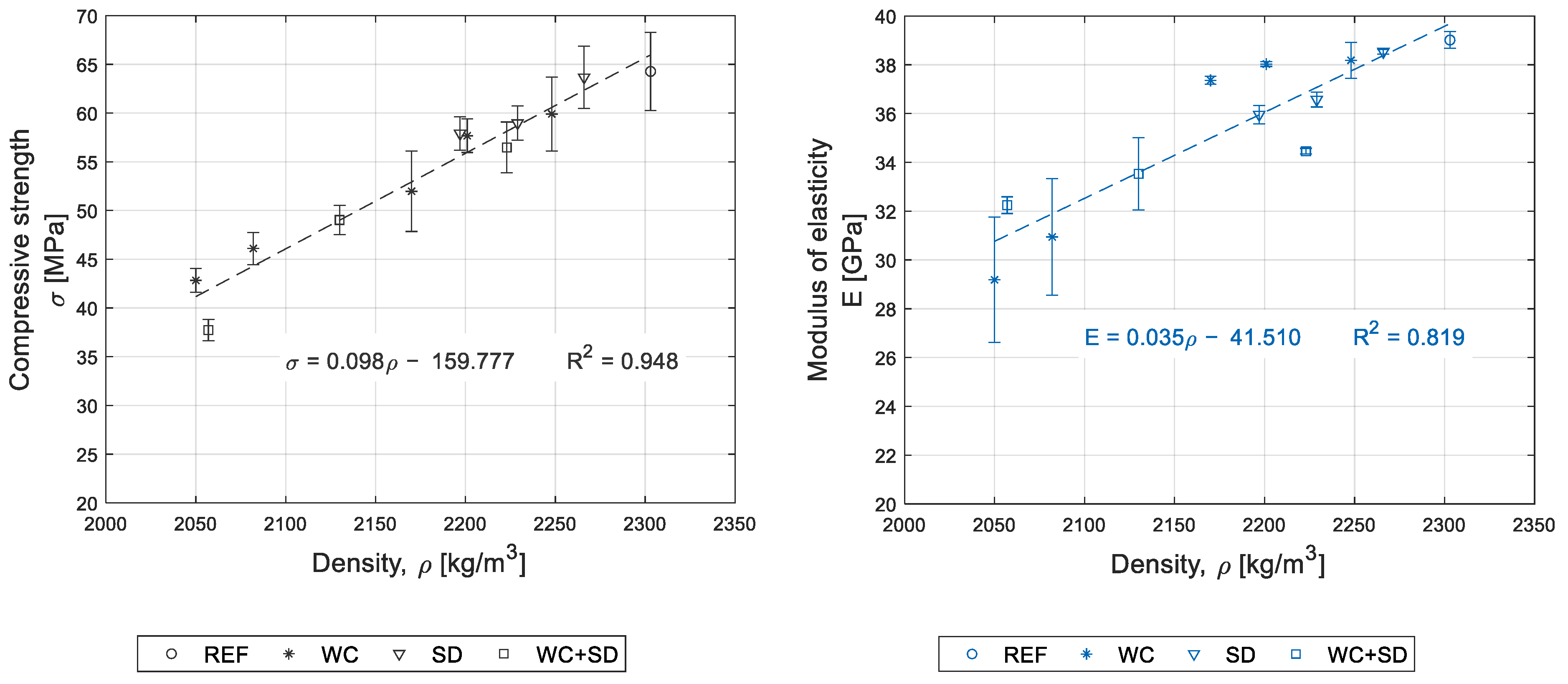
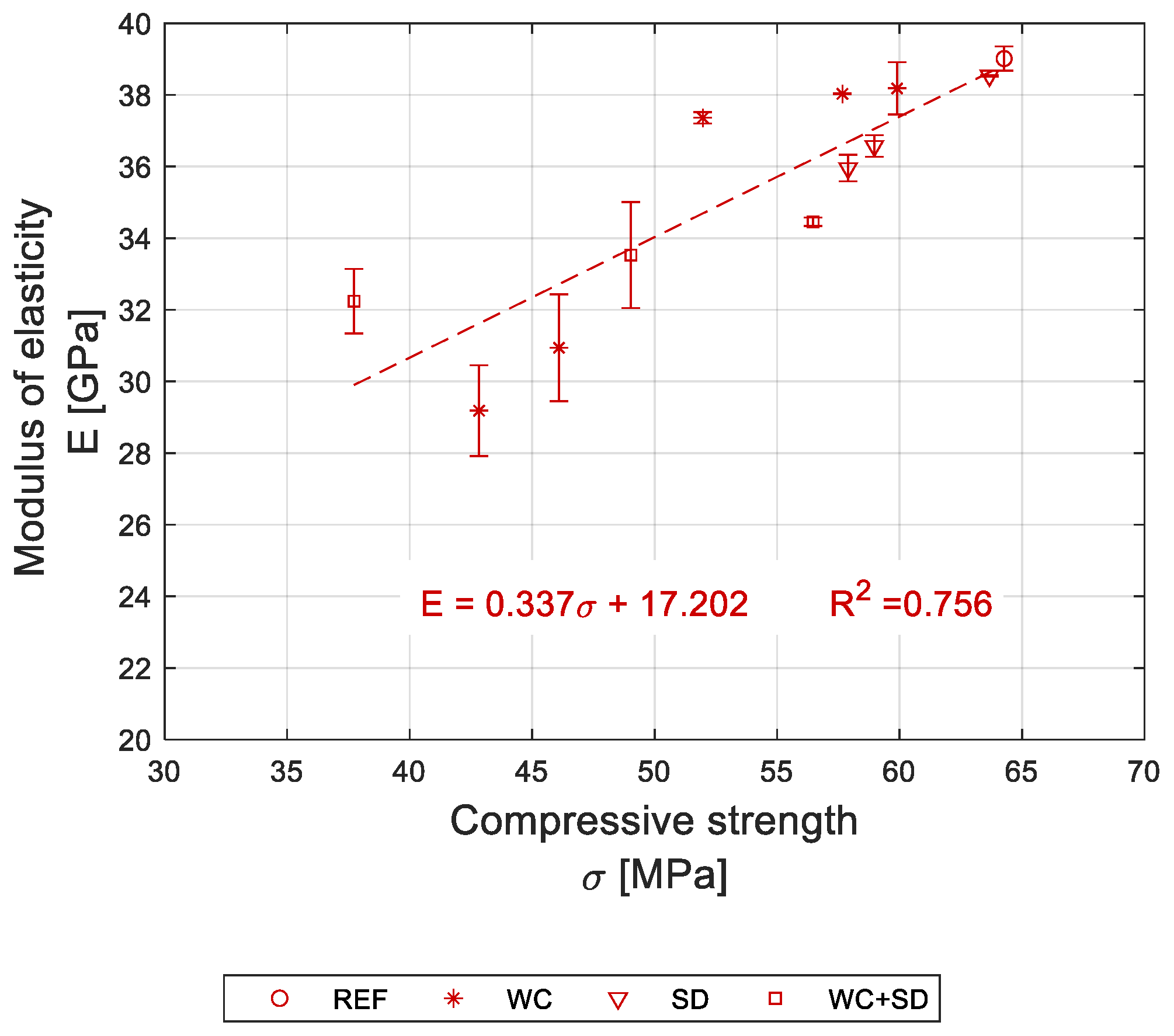

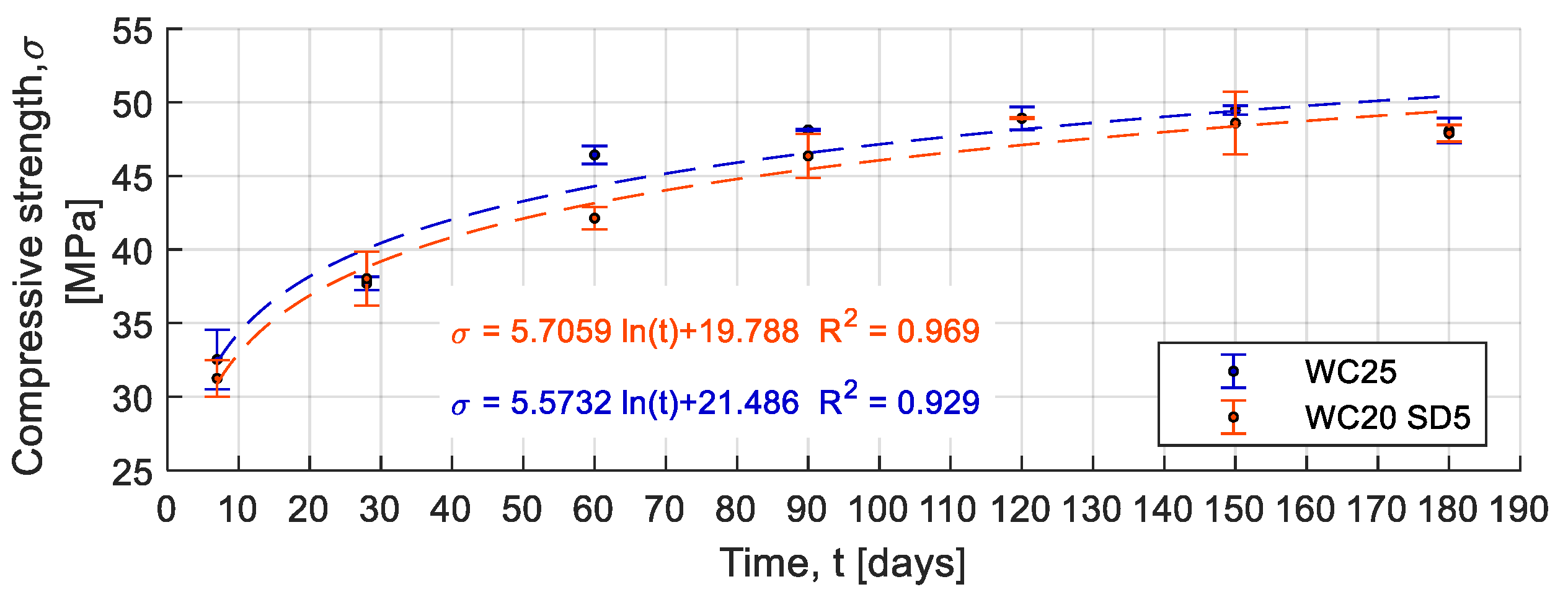
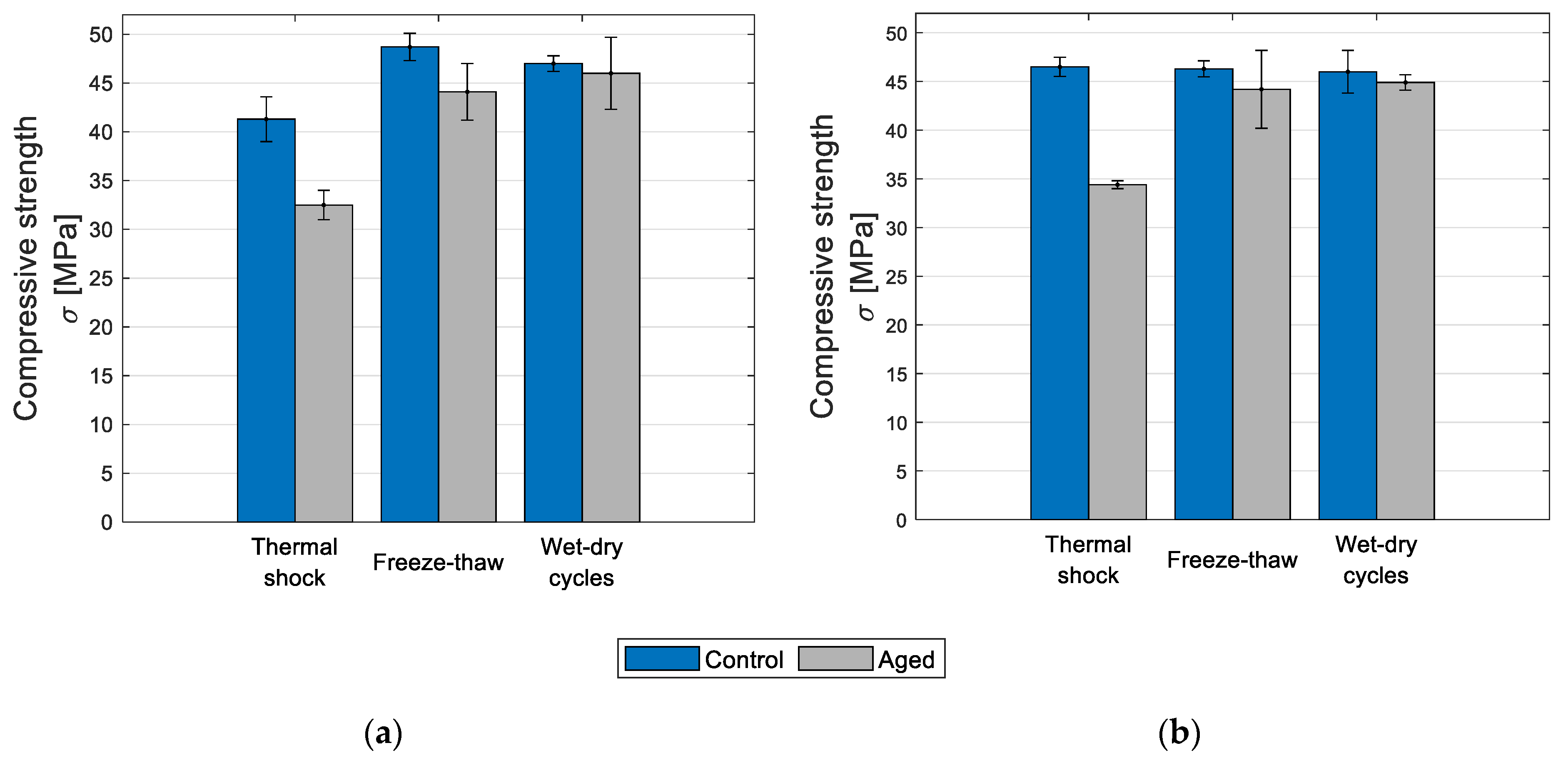
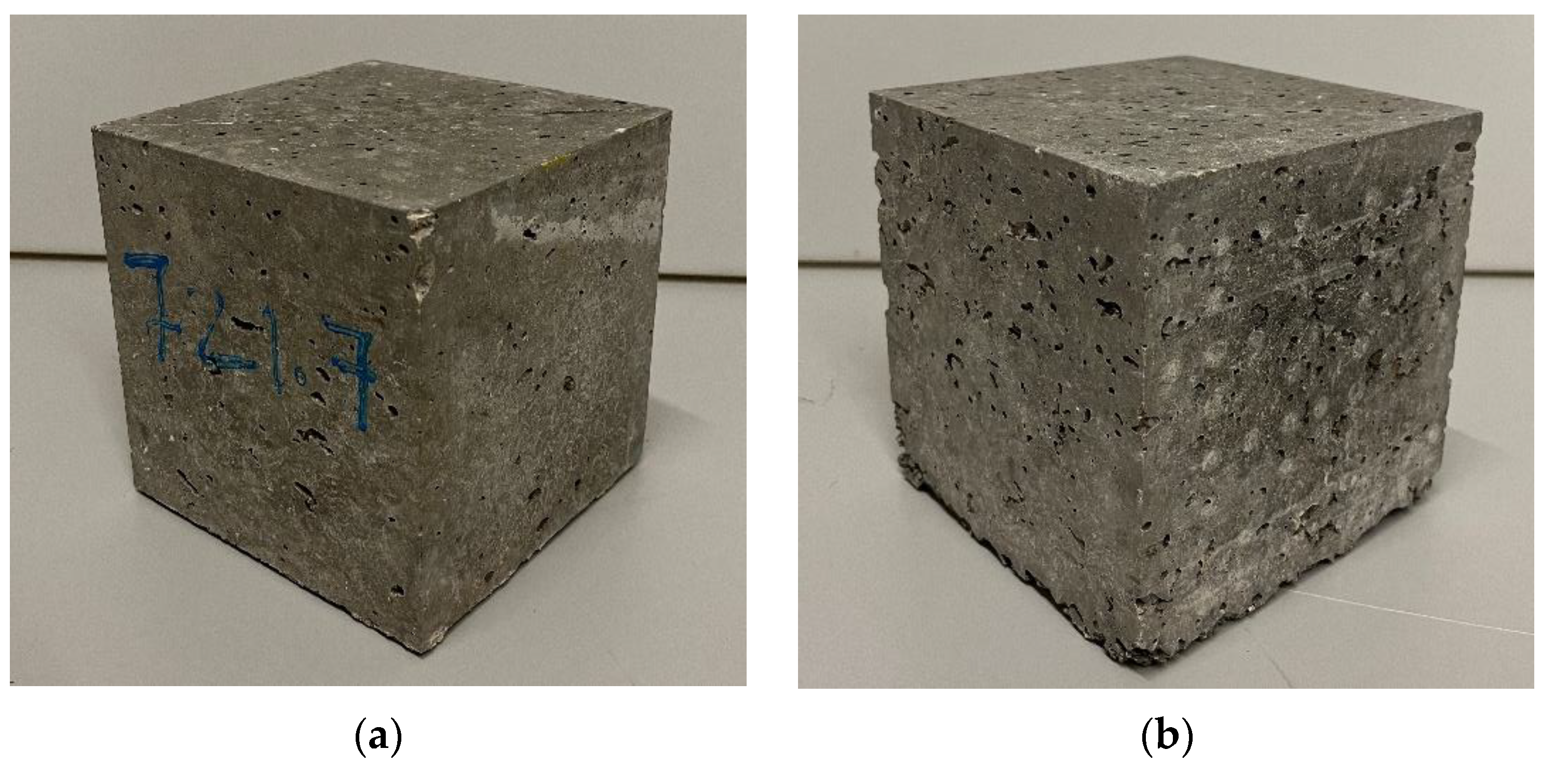
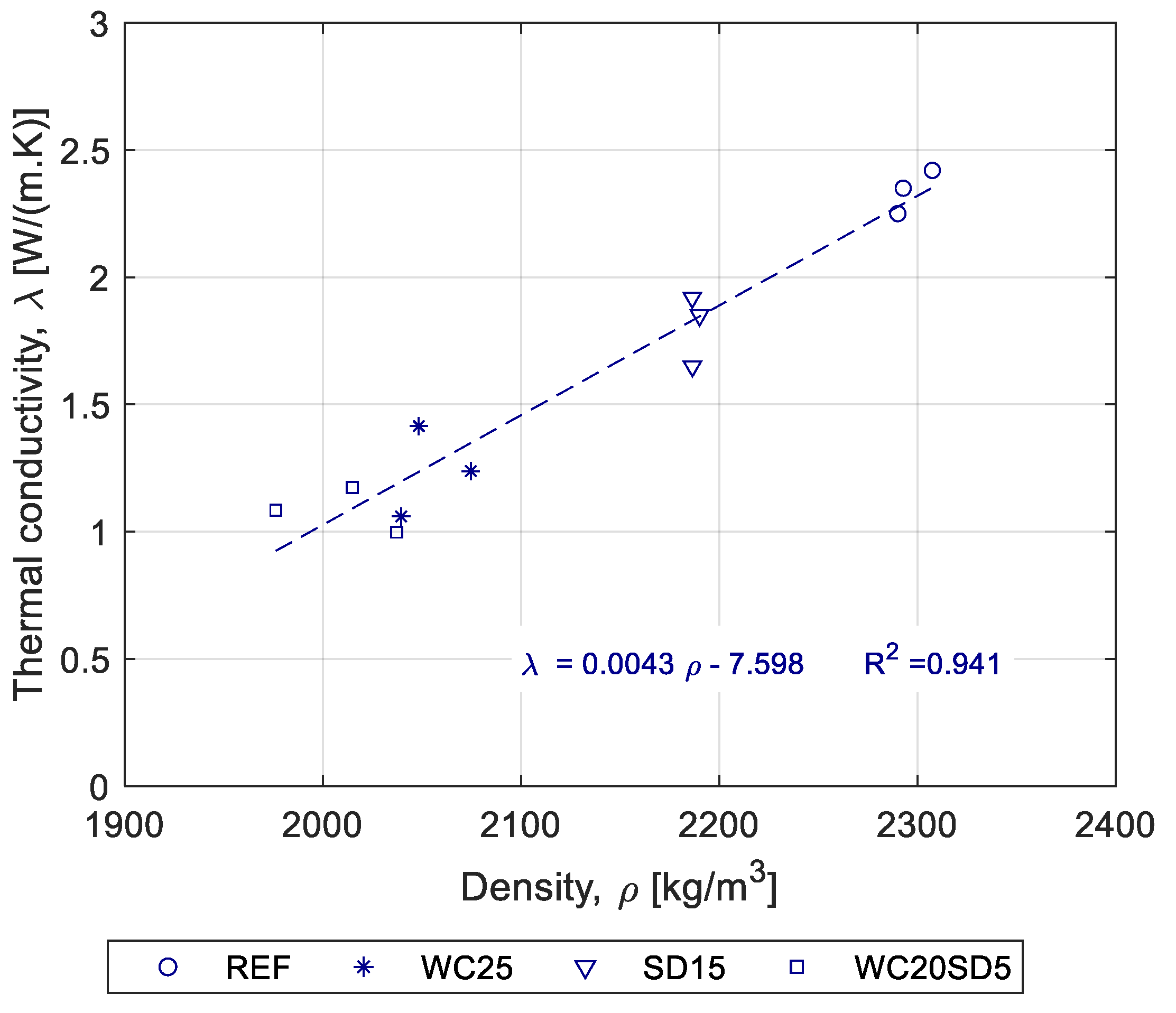
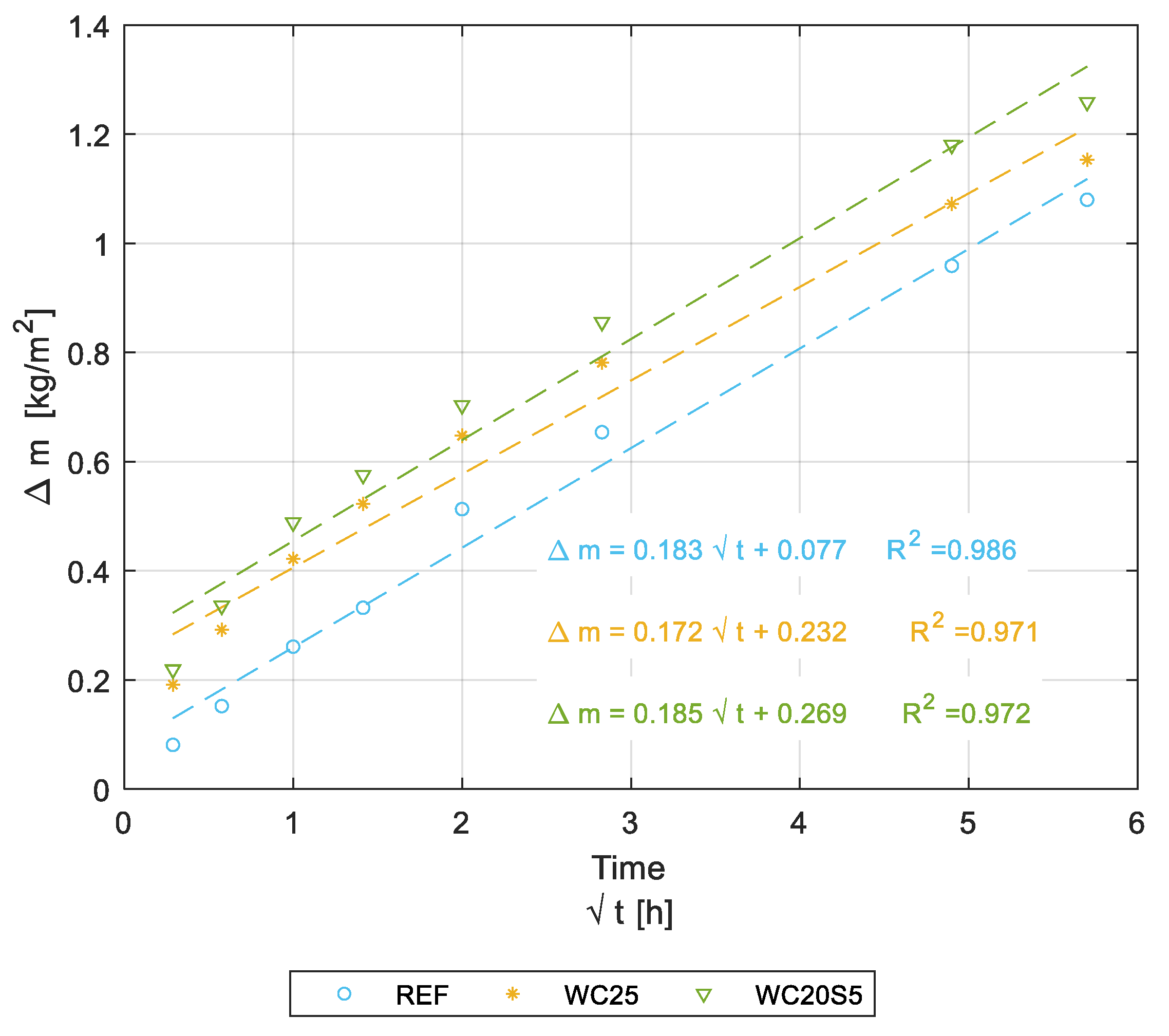
| Reference | Year | Composites Type |
|---|---|---|
| [7] | 2017 | Sand concrete with a wood-to-cement weight ratio of 1 23 (w/c = 0.26, Portland cement type II A-L 42.5 R). |
| [16] | 2007 | Sand concrete incorporating wood shavings with proportions varying from 0 to 100 kg/m3. |
| [17] | 2015 | Wood cement compounds based on sawdust and mineralized wood fiber. Different binders were used (standard Portland cement CEM I 52.5, CEM II 42.5 N, and aluminate cement), different wood/cement ratios were considered (0.33 and 0.2) as well as different w/c ratios (0.35 to 0.56). |
| [18] | 2020 | Concrete with replacement of 15% in volume of coarse aggregates by wood chip (w/c = 0.598, Portland cement CEMII/B–S 42.5 R). |
| [19] | 2022 | Concrete with replacement varying from 0 to 50% of sand by wood chip (w/c = 0.50, Portland cement type I 42.5 N). |
| [20] | 2021 | Sand concrete with replacement varying from 0 to 50% of sand by wood chip (w/c = 0.49, Portland cement type I 42.5 N). |
| [21] | 2019 | Concrete blocks with replacement varying from 0 to 40% of gravel by wood chip (w/c = 0.41). |
| [22] | 2021 | Concrete with replacement varying from 0 to 60% of sand by sawdust while coarse aggregates remain unchanged (w/c = 0.45, Portland cement type II/B-M). |
| [23] | 2020 | Concrete with replacement of 15% of coarse aggregates by wood chip (w/c = 0.598, Portland cement type II/B-S 42.5 R). |
| [24] | 2018 | Concrete with replacement of varying from 0 to 15% of sand by sawdust while coarse aggregates remain unchanged (w/c = 0.50, Portland cement type I). |
| [25] | 2021 | Sand concrete with replacement of varying from 0 to 30% of sand by sawdust (Portland cement type II of class 45). |
| [26] | 2022 | Concrete with replacement of cement by fly ash (varying from 0 to 20%), of sand by sawdust (10 and 40%), PET (0 to 60%), or polystyrene (0 and 20%) (w/c = 0.5, Portland cement type II 42.5 R). |
| Aggregates | S0/4 | G0/5 | G1 | |
|---|---|---|---|---|
| Particle density (kg/m3) | Oven dry | 2640 ± 30 | 2620 ± 5 | 2620 ± 20 |
| Saturated surface dry | 2650 ± 20 | 2630 ± 10 | 2630 ± 15 | |
| Nominal maximum size (mm) | 8 ± 0 | 10 ± 0 | 16 ± 0 | |
| 24 h water absorption (%) | 0.1 ± 0.0 | 0.4 ± 0.0 | 0.3 ± 0.0 | |
| Water content (%) | 1.6 ± 0.2 | 0.1 ± 0.0 | 0.1 ± 0.0 | |
| Aggregates | Particle Density (kg/m3) | Nominal Maximum Size (mm) | 24 h Water Absorption (%) | Free Surface Water (%) | |
|---|---|---|---|---|---|
| Oven Dry | Saturated Surface Dry | ||||
| Wood chips | 410 ± 20 | 1090 ± 35 | 16 ± 0 | 200 ± 12 | 33 ± 5 |
| Sawdust | 340 ± 15 | 1110 ± 60 | 4 ± 0 | 411 ± 59 | 190 ± 24 |
| Series | Compositions (kg/m3) | |||||||
|---|---|---|---|---|---|---|---|---|
| Cement | S0/4 | G0/5 | G1 | WC | SD | Added water | SP | |
| REF | 400 | 690 | 467 | 674 | - | - | 162 | - |
| WC5 | 400 | 626 | 444 | 670 | 43 | - | 133 | 2 |
| WC10 | 400 | 562 | 421 | 665 | 86 | - | 105 | 2 |
| WC15 | 400 | 498 | 397 | 661 | 128 | - | 76 | 3 |
| WC20 | 400 | 434 | 374 | 657 | 171 | - | 48 | 4 |
| WC25 | 400 | 370 | 351 | 653 | 214 | - | 19 | 5 |
| SD5 | 400 | 598 | 467 | 674 | - | 60 | 113 | 3 |
| SD10 | 400 | 507 | 467 | 674 | - | 121 | 65 | 4 |
| SD15 | 400 | 415 | 467 | 674 | - | 181 | 16 | 5 |
| WC7.5SD7.5 | 400 | 457 | 432 | 667 | 64 | 90 | 46 | 4 |
| WC12.5SD7.5 | 400 | 393 | 409 | 663 | 107 | 90 | 18 | 5 |
| WC20SD5 | 400 | 342 | 374 | 657 | 171 | 60 | 0 | 5 |
| Section | Property | Curing/Conditioning | Test | Series |
|---|---|---|---|---|
| Mechanical | Compressive strength | Curing in water tank | Compressive strength | all |
| Poisson’s ratio and modulus of elasticity | Curing in water tank | Poisson’s ratio and modulus of elasticity | all | |
| Flexural strength | Curing in water tank | Flexural strength | REF WC15 WC25 SD15 WC7.5SD7.5 WC20SD5 | |
| Durability | Compressive strength development over time (for comparison purposes) | Curing in water tank | Compressive strength | WC25 WC20SD5 |
| Wet–dry cycles | Curing in water tank followed by wetting–drying cycles | Compressive strength | WC25 WC20SD5 | |
| Freeze–thaw cycles | Curing in water tank followed by freeze–thaw cycles | Compressive strength | WC25 WC20SD5 | |
| Thermal shock | Curing in water tank followed by thermal shock | Compressive strength | WC25 WC20SD5 | |
| Hygrothermal | Thermal conductivity | Curing in water tank followed by conditioning at ambient conditions | The guarded hot plate method | REF SD15 WC25 WC20SD5 |
| Shrinkage and expansion | Shrinkage: curing in climatic chamber Expansion: curing in water tank | Shrinkage and expansion | REF WC25 WC20SD5 | |
| Water absorption | Curing in water tank followed by conditioning at ambient conditions | Water absorption coefficient | REF WC25 WC20SD5 |
| Series | Density (kg/m3) | Compressive Strength (MPa) | |
|---|---|---|---|
| 28 d | 7 d | 28 d | |
| REF | 2303 ± 18 | 57.97 ± 0.42 | 64.27 ± 4.00 |
| WC5 | 2248 ± 6 | 55.53 ± 1.53 | 59.90 ± 3.81 |
| WC10 | 2201 ± 2 | 49.30 ± 1.35 | 57.67 ± 1.72 |
| WC15 | 2170 ± 2 | 46.37 ± 1.60 | 51.97± 4.12 |
| WC20 | 2082 ± 9 | 39.60 ± 2.61 | 46.10 ± 1.65 |
| WC25 | 2050 ± 15 | 34.80 ± 3.14 | 42.83 ± 1.21 |
| SD5 | 2266 ± 33 | 57.30 ± 1.15 | 63.67 ± 3.20 |
| SD10 | 2229 ± 14 | 51.10 ± 0.95 | 58.97 ± 1.76 |
| SD15 | 2197 ± 24 | 50.37 ± 2.08 | 57.90 ± 1.71 |
| WC7.5SD7.5 | 2223 ± 15 | 50.87 ± 0.45 | 56.47 ± 2.61 |
| WC12.5SD7.5 | 2130 ± 2 | 42.30 ± 0.50 | 49.03 ± 1.50 |
| WC20SD5 | 2057 ± 12 | 31.60 ± 1.21 | 37.73 ± 1.08 |
| Series | Dynamic Modulus of Elasticity (GPa) | Poisson’s Ratio | |
|---|---|---|---|
| 7 d | 28 d | 28 d | |
| REF | 37.59 ± 0.02 | 39.01 ± 0.34 | 0.32 ± 0.01 |
| WC5 | 36.89 ± 0.37 | 38.18 ± 0.73 | 0.34 ± 0.01 |
| WC10 | 37.40 ± 0.39 | 38.03 ± 0.01 | 0.33 ± 0.00 |
| WC15 | 36.11 ± 0.76 | 37.36 ± 0.16 | 0.34 ± 0.03 |
| WC20 | 30.94 ± 1.39 | 32.11 ± 1.49 | 0.32 ± 0.02 |
| WC25 | 29.18 ± 2.57 | 31.55 ± 1.27 | 0.30 ± 0.03 |
| SD5 | 38.17 ± 0.30 | 38.53 ± 0.02 | 0.33 ± 0.01 |
| SD10 | 36.63 ± 0.65 | 36.57 ± 0.30 | 0.33 ± 0.01 |
| SD15 | 35.25 ± 0.29 | 35.95 ± 0.37 | 0.34 ± 0.00 |
| WC7.5SD7.5 | 34.76 ± 0.21 | 34.46 ± 0.12 | 0.34 ± 0.00 |
| WC12.5SD7.5 | 34.54 ± 0.05 | 33.53 ± 1.48 | 0.32 ± 0.02 |
| WC20SD5 | 30.11 ± 0.38 | 31.55 ± 0.90 | 0.29 ± 0.03 |
| Series | Ww24 [kg/(m2⋅h0,5)] | Total Water Absorption (%) |
|---|---|---|
| REF | 0.18 ± 0.03 | 0.9 ± 0.1 |
| WC25 | 0.18 ± 0.02 | 1.0 ± 0.1 |
| WC20SD5 | 0.19 ± 0.02 | 1.1 ± 0.1 |
| Series | Shrinkage (10−4) | Expansion (10−5) |
|---|---|---|
| REF | 4.45 ± 0.33 | 7.0 ± 1.6 |
| WC25 | 2.65 ± 1.67 | 1.9 ± 2.0 |
| WC20SD5 | 4.44 ± 0.22 | 1.9 ± 1.8 |
| Property | WC25 | WC20SD5 | Reported Values from the Literature | |
|---|---|---|---|---|
| Physical and Mechanical | Compressive strength at 28 d (MPa) | 42.83 ± 1.21 | 37.73 ± 1.08 | 7.9 ± 0.66 [19] 7.3 [20] ≈11 [21] ≈7 [22] 25.8 ± 3.79 [23] ≈34 [24] |
| Density (kg/m3) | 2050 ± 15 | 2057 ± 12 | 764.06 ± 36.35 [7] 1706 ± 1.55 [19] 2217 [22] 2200 [23] 2173 [24] 2408.4 [44] (a) 2307 [49] (b) | |
| Poisson’s ratio | 0.30 ± 0.03 | 0.29 ± 0.03 | 0.296 [44] (a) 0.11 [49] (b) 0.241 [50] (c) | |
| Modulus of elasticity (GPa) | 31.55 ± 1.27 | 31.55 ± 0.90 | ≈12 [19] 31.44 [35] (d) 23.98 [44] (a) 48.25 [50] (c) | |
| Flexural strength (MPa) | 5.3 ± 0.35 | 5.02 ± 0.84 | 2.5 [7] 1.8 [20] ≈2 [22] | |
| Durability (loss of compressive strength) | Wet–dry cycles (%) | 2 | 2 | - |
| Freeze–thaw cycles (%) | 9 | 5 | - | |
| Thermal shock (%) | 21 | 26 | - | |
| Hygrothermal | Thermal conductivity [W/(m·k)] | 1.24 ± 0.18 | 1.09 ± 0.09 | 2.00 [24] 0.8 [25] 0.89 [26] 1.05 [26] |
| Shrinkage | 2.65 ± 1.67 (10−4) | 4.44 ± 0.22 (10−4) | - | |
| Expansion | 1.9 ± 2.0 (10−5) | 1.9 ± 1.8 (10−5) | - | |
| Water absorption at 24 h (%) | 1.0 ± 0.1 (%) | 1.1 ± 0.1 (%) | 29.7 ± 4.54 [7] 15.1 [19] 17.6 [20] 3.62 [24] |
Publisher’s Note: MDPI stays neutral with regard to jurisdictional claims in published maps and institutional affiliations. |
© 2022 by the authors. Licensee MDPI, Basel, Switzerland. This article is an open access article distributed under the terms and conditions of the Creative Commons Attribution (CC BY) license (https://creativecommons.org/licenses/by/4.0/).
Share and Cite
Dias, S.; Tadeu, A.; Almeida, J.; Humbert, P.; António, J.; de Brito, J.; Pinhão, P. Physical, Mechanical, and Durability Properties of Concrete Containing Wood Chips and Sawdust: An Experimental Approach. Buildings 2022, 12, 1277. https://doi.org/10.3390/buildings12081277
Dias S, Tadeu A, Almeida J, Humbert P, António J, de Brito J, Pinhão P. Physical, Mechanical, and Durability Properties of Concrete Containing Wood Chips and Sawdust: An Experimental Approach. Buildings. 2022; 12(8):1277. https://doi.org/10.3390/buildings12081277
Chicago/Turabian StyleDias, Sara, António Tadeu, João Almeida, Pedro Humbert, Julieta António, Jorge de Brito, and Pedro Pinhão. 2022. "Physical, Mechanical, and Durability Properties of Concrete Containing Wood Chips and Sawdust: An Experimental Approach" Buildings 12, no. 8: 1277. https://doi.org/10.3390/buildings12081277
APA StyleDias, S., Tadeu, A., Almeida, J., Humbert, P., António, J., de Brito, J., & Pinhão, P. (2022). Physical, Mechanical, and Durability Properties of Concrete Containing Wood Chips and Sawdust: An Experimental Approach. Buildings, 12(8), 1277. https://doi.org/10.3390/buildings12081277









